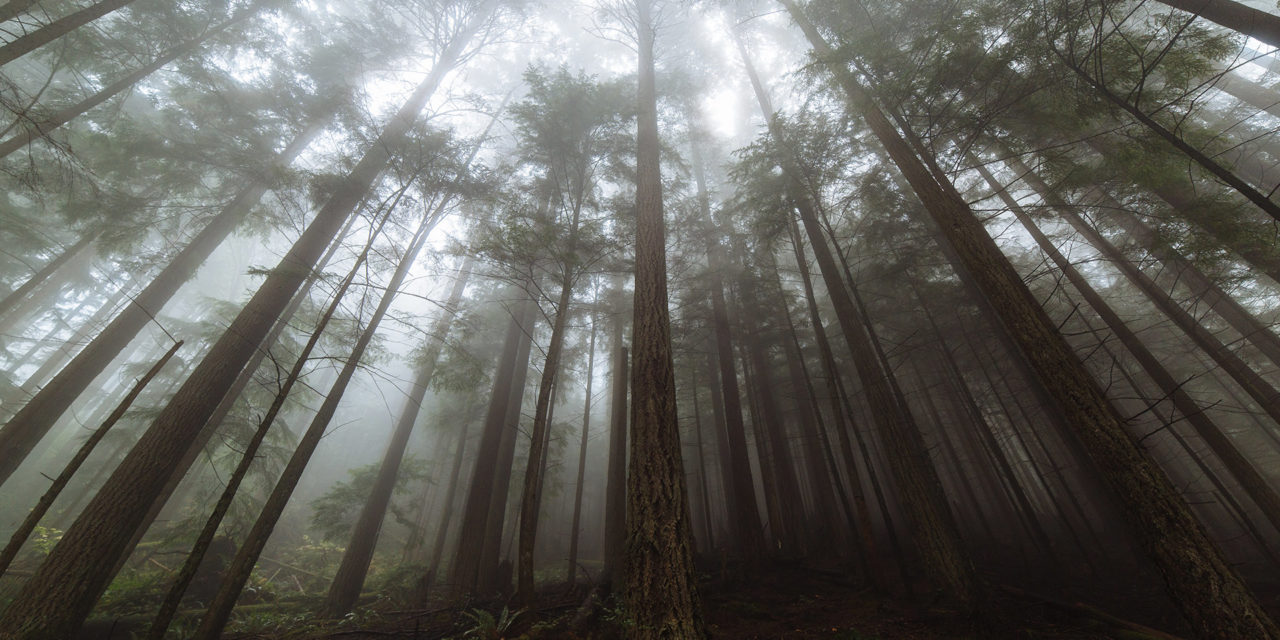Once upon a time, back before “Zoom church” was a thing, our community worshipped in the wild once a month. Our sanctuary was a circle of second or third generation bigleaf maples and Douglas firs in a small but magical forest next to Lake Whatcom. Or sometimes in a snow-covered city park. Or often at the bay shore—using driftwood logs for benches, brewing cedar tea, and gathering blackberries for communion.
Church of the Wild is a Christ-centered way to practice—to really practice, in community—a sort of radical intimacy with the world. The movement began as a phenomenon of isolated pastors and spiritual leaders taking courageous steps to leave buildings and to begin to heal the rift between nature and spirit. Each of us felt a little nutty, on our own, and unsure of ourselves as we made up new liturgies, orders of service, and spiritual practices that included elements of all creation in our worship. Eventually, we began to find one another, meet for support, and to share ideas . . . and we became a network. Now, hundreds of pastors from dozens of denominations connect through the Wild Church Network, one of many small coalitions emerging with similar values—groups like Farm Church, Garden Church, Agrarian Church, Eco-Church, Watershed Discipleship gatherings, and Creation Spirituality Communities.
In my role as a Wild Church pastor, I lead people into the woods or along the shore of salmon-traveled rivers; more often in these COVID-19 days, I simply invite congregants into their own yards. My objective: to engage in direct, contemplative, even mystical conversation with God in and through the stunning natural world of the Pacific Northwest.
The echoing canticles of a Swainson’s thrush may lead the hymns. A single goose, encountered on a solo wandering that is part of the service, may draw our attention. Mourning the loss of her mate, she offers the sermon, widening the scope of the Lenten scripture for the day. Her words, collapsing the language barrier, break open our own unwept tears of loneliness and—connect us? —inescapably to the other beings in our watershed who might be experiencing their own love and grief. After offering communion, when the leaves rustle and the wind dances through, we might, in a sacred, silent moment, consider that we are connected to a much larger story. We might then end with a responsive prayer, or a benediction like this one from Dostoevsky:
Love all of God’s creation, the whole of it and every grain of sand. Love every leaf, every ray of God’s light! Love the animals. Love the plants, love everything. If you love everything, you will soon perceive the divine mystery in things. Once you perceive it, you will begin to comprehend it better every day. And you will come at last to love the whole world with an all-embracing love.
Church of the Wild is not a new trendy form of church just for people who shop at REI and backpack the Pacific Crest Trail. It’s not even a sneaky way to get religious people to care about climate change. Rather, Wild Churches make up a network of like-minded communities, a movement growing in the margins of multiple Christian denominations—one that resists a destructive worldview of separation and domination over Creation, and cultivates instead a worldview of radical intimacy and belonging.
Wild Church has roots in pivotal moments in history—moments of crisis and transformation—when the people of God are sent into the wilderness. On purpose, Jesus went to the mountains to pray—a detail important enough that all the synoptic gospels mention it. Yet in our contemporary quest to become better pray-ers, we seem to leave it off the list. Centering prayer, Taize prayer, silent prayer, petition prayer, liturgical prayer, confession prayer, pray-without-ceasing prayer. But when was the last time you were taught how to go to the mountain? Jesus didn’t go to the synagogues to pray; Jesus went into the wilderness. And yet we tend to skip over that part of the sentence when we look to the scriptures to learn how Jesus prayed.
Spiritual experiences in the wilderness are deeply embedded in the Judeo-Christian religious tradition. But after generations of individualism, and a focus on personal salvation and cultural detachment from the rest of the living world, the church has lost connection with the actual wildlands, waters, elements, and creatures that were and remain crucial to our spiritual development.
Before founding Wild Church, when I was a preacher for indoor churches for 20 years, I mostly spiritualized “wilderness” as a metaphor to describe tough times or those “dark nights of the soul.” Eventually, though, I began to wonder what role the actual wilderness played in those biblical stories. From Moses to Jesus, Isaiah to Paul, the uncompromising directive from God to enter the wilderness at pivotal moments in history had to mean something more than internal wrestling with ego or demons. And what role did the actual physical dirt and heat and burning bushes and wild creatures play in their (and therefore our) spiritual formation?
The Hebrew word for wilderness is MIDBAR, which is derived from DABAR, which means Speaking. Midbar, specifically, is the organ that speaks. In Exodus 13:18, for example, “God led the people around by way of the wilderness (midbar).” Wilderness is in fact included in the Old Testament over 300 times. What if the freed slaves were sent into the wilderness not as some sort of punishment or intense object lesson, but simply in order to listen—to listen to the Sacred speaking through and in and with the wilderness? What if God sent the Israelites (and so many other leaders in the old stories) into the wilderness simply to speak to them? What if God actually knows what God is doing, and there is no better way to re-program the effects of the deeply embedded trauma of slavery? For forty years God’s people wandered the wilderness until a whole generation passed. Only after they learned how to listen and converse with the living God again—as freed and wild human beings, in interdependent relationship with one another and with the land—only then were they invited into the promised land.
What if we, too, are being called into our own wilderness at our own pivotal moment in history? What if there is something inherently calming and focusing about being present in nature that opens up receptivity for a divine encounter? What if wilderness is where we might find God’s answers to our own cultural oppression?
As we sit in our homes, awaiting the outcomes of the global pandemic, we are offered the opportunity to face squarely a historically pivotal moment for our own time. This global struggle shared in common tears the veil; we can’t look away anymore from the reality, both tragic and beautiful, that everything is interconnected. Humans, animals, trees; oceans, bacteria, bees. God. A new worldview is vying to replace a very different and dominant one that isolates human beings at the top of a valuation hierarchy. The old way values only serve those in ascendance: Forests become lumber. Cows become beef. People of color became an irrational threat. The “othering” power of the old way has led (and still leads) to abuse of land and oppression of people. The old way has put us at odds with the earth and has led us to the brink of environmental collapse and catastrophic climate crisis.
A new worldview, beyond dominion and even stewardship, is emerging—and it is at the heart of what the Wild Church movement is about. It is a worldview of belonging—a kin-dom of God that includes the whole system of life. It regards all species as inherently good and valuable—that loves neighbors—all neighbors—as ourselves. That does unto others—all others—as we would have them do unto us. The global transformation that needs to happen (especially if we are to survive the crises created by the old paradigm) is rooted in a spirituality that is native to the message and heart of Jesus.
The transition to a worldview where sustainable and just practices can naturally emerge will not be easy. Any challenge to the dominant system requires knowledge, awakening, transformation, and empowerment. We will need practitioners of place-based theology, environmental philosophers, wilderness guides, peacebuilders, indigenous voices, tellers of ancient stories, and pastors (both ordained in the institution and not) to contribute to a new vision for what church might become. Even the more established, mainstream churches have a unique, urgently important role to play in providing a foundation of support and theological grounding for this cultural shift.
And so, in the fellowship of cedar trees and woodpeckers, our Wild Church community continues to seek an expansion of our experience of prayer, and to learn how and why Jesus went to the mountain to do it. There is an unmediated presence of God to be experienced outside of the human constructs of civilization . . . a reconnection that happens when we enter into an intentional and reverent relationship with the natural world.
As we lean back in our backpacking chairs off a trail in southern Bellingham, we are struck with awe. Listening in on the conversation happening between the vine maple leaves and the wind, we open ourselves to the real presence of Christ in all things. And from this receptive posture, we ask where we might be most needed today, this week. And we ask how we might best offer ourselves to the renewing of the world at this pivotal and transformative time.


